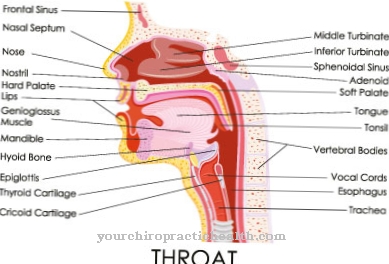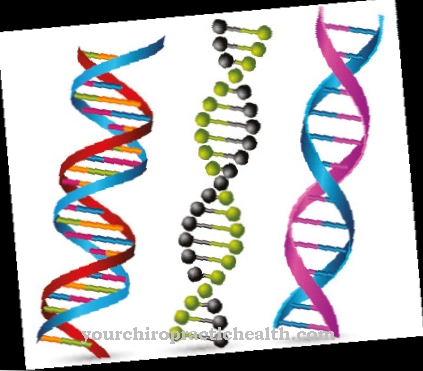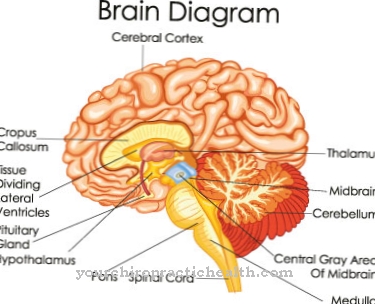The Angelman Syndrome (AS) is characterized by a delay in physical and mental development. People with Angelman syndrome require lifelong constant care, as they can neither take care of themselves nor correctly assess dangers. The rare genetic disease got its name from the British pediatrician Harry Angelman, who was the first to describe the disease from a scientific point of view in 1965.
What is Angelman Syndrome?

© fancytapis - stock.adobe.com
Outwardly, people with Angelman syndrome have a flat back of the head, a large mouth with a protruding lower jaw, and a wide-legged, uncoordinated gait.
Other characteristics of Angelman syndrome are poorly pigmented skin and small hands and feet. Scoliosis, an S-shaped curvature of the spine, often occurs during puberty. 90 percent of people with Angelman syndrome have epilepsy. Particularities in behavior are expressed, among other things, in a cheerful mood with frequent smiles and laughter, a noticeable enthusiasm for water and an intensive search for physical closeness.
Difficulty concentrating, the inability to speak and an above-average length of the oral phase are also characteristic of Angelman syndrome.
causes
The causes of Angelman syndrome are hereditary. The most common is an abnormality inherited from the mother on the 15th chromosome. Most often, this abnormality is that small sections of the chromosome are missing.
In contrast, ten percent of the anomaly is a gene mutation. In these cases, no defective sections on chromosome 15 were found in the mother of the child with Angelman syndrome. It is therefore possible that the abnormality arose during the development of an egg cell.
In individual cases, the cause of Angelman syndrome can also be that both chromosomes 15 come from the father alone. About ten percent of people with Angelman syndrome had no abnormalities in the 15th chromosome pair. The change in the genetic makeup may be too small and cannot be determined with the currently available technology.
Symptoms, ailments & signs
Angelman syndrome manifests itself through a variety of physical symptoms and behaviors. The typical signs usually only appear after the age of three and affect the entire body. First of all, the affected children suffer from movement or balance disorders, which can vary in severity. Typical are the uncoordinated gait and the jerky movements of the arms and legs.
In addition, hypermotor and hyperactive behavior can be determined - those affected are restless and move uninterruptedly. Language development is usually impaired. Those affected understand what is being said to them, but in most cases they cannot speak themselves.
In general, physical and mental development is delayed, which manifests itself in the course of the disease through increasing retardation and various physical limitations. In addition, Angelman Syndrome can cause many other symptoms. Affected children often have epileptic seizures or suffer from so-called microcephaly, a head that is too small.
Further external features are the pronounced jaw and the wide mouth, the widely spaced teeth, strabismus and wide-legged walking with feet turned outwards. Affected children are also fascinated by water, crackling paper and plastic and have unusual eating habits. The poorly pigmented skin, combined with light hair and light eye color, is also typical.
Diagnosis & course
To date, two methods are known to diagnose Angelman syndrome. Between the ages of three and seven, child neurologists notice abnormal EEG values.
A positive genetic test provides certainty whether the child was born with Angelman syndrome. In infancy and early toddlerhood, the existing developmental problems in Angelman syndrome are hardly noticeable. Diagnoses are made with an average frequency of 1: 15,000 to 1: 20,000.
There may be several more cases of this peculiarity. Angelman syndrome is often not diagnosed at all. Instead, it is assumed to be autism. Both boys and girls have the same chance of being born with Angelman syndrome. The life expectancy of people with Angelman syndrome is normal. Remedial early support can greatly improve their independence.
Complications
In Angelman syndrome there are mainly mental and physical developments. The person concerned often laughs for no reason. This can appear repulsive and strange to many people, so that they isolate them socially. In addition, hyperactive and hypermotor behavior is observed, so that the risk of injury is high.
Angelman syndrome is more likely to have epileptic seizures, which can cause injuries. In addition, life-threatening status epilepticus can occur. This particularly long-lasting attack can occur several times in a row and is difficult to treat, which is why an emergency doctor should be called in immediately and intensive care should be scheduled.
In addition, a patient has squinting (strabismus). In the early years, this should be treated as quickly as possible, as it can no longer be reversed in school age and can thus lead to poor vision (amblyopia). After an operation, there is always the risk that the squint will return, so that another operation of the eye muscles is necessary.
Another complication of Angelman syndrome is curvature of the spine (scoliosis). Over the years, the vertebral bodies and their intervertebral discs wear out more and more, causing severe pain. The thorax also becomes smaller, organs are narrowed and their function is restricted, such as the heart or the lungs.
When should you go to the doctor?
If Angelman syndrome is suspected, parents should speak to their pediatrician or a child neurologist. A variety of physical symptoms and behaviors can be used to determine whether this is the condition. If this clinical picture (delayed mental and physical development, movement and balance disorders, etc.) is noticed, a doctor is recommended.
In particular, the main feature, very frequent and baseless smiles, should give rise to a medical evaluation. The symptoms usually appear between the ages of 3 and 7 and can be assigned by using information brochures and forums. A medical diagnosis should nevertheless take place so that suitable therapeutic measures can be initiated quickly.
Discussions with psychologists and other affected parents should always be part of the treatment. Parents should also consider attending special discussion groups for children with Angelman syndrome. In some cases with Angelman syndrome, the emergency doctor needs to be called in. Then, for example, when seizures occur or an accident occurs as a result of movement and balance disorders.
Doctors & therapists in your area
Treatment & Therapy
Angelman syndrome is currently not curable. However, adequate measures to treat the physical complaints are medically relevant. Physiotherapy is suitable for stabilizing the spine in order to counteract possible consequential damage caused by scoliosis, which occurs in many people with Angelman syndrome.
It may be necessary to give appropriate medication to prevent epileptic seizures. People with Angelman syndrome may have impaired language development and almost never speak themselves. Nevertheless, they have a good understanding of language. With professional support, those affected are quite capable of learning alternative forms of communication such as sign-supported communication or visual communication.
Therapeutic riding enables children with Angelman Syndrome to improve their sense of balance and thus to run more safely. Other therapeutic measures to improve fine motor skills, independence and body awareness are occupational therapy, speech therapy and sensory integration therapy.
In addition, attentive care, loving attention and intensive educational support have a positive effect on people with Angelman syndrome.
Outlook & forecast
As a rule, Angelman syndrome has a very negative effect on the patient's development and can greatly delay it. Not only the mental, but also the physical and motor development of the patient is restricted, so that there are severe limitations and difficulties in adulthood. Not infrequently, those affected are then dependent on the help of other people. This leads to disorders of coordination and concentration. Reading and writing are also usually difficult for those affected by Angelman syndrome and speech disorders occur.
Furthermore, the patients can also suffer from epileptic seizures, which in the worst case can lead to death. The behavior of those affected is hyperactive, as a result of which parents and relatives often suffer from psychological complaints or depression.
A direct causal treatment of this disease is usually not possible. Those affected are dependent on therapies and the help of other people throughout their lives. As a rule, it cannot be universally predicted whether the disease will also lead to a reduced life expectancy.
prevention
Angelman syndrome cannot be prevented. Genetic testing during pregnancy makes it possible to detect Angelman syndrome in the unborn child. However, such a procedure carries numerous risks and should only be carried out after careful consideration in consultation with the treating doctor. An ultrasound scan cannot determine Angelman syndrome.
Aftercare
With Angelman syndrome, follow-up care options are usually very limited. Since it is a hereditary disease, it cannot be treated completely and even only symptomatically. The affected person is mostly dependent on lifelong therapy.
If you still want to have children, genetic counseling can also be carried out to prevent Angelman syndrome from being passed on to the children. Treatment of the syndrome is usually done through physical therapy and various exercises. These can also be carried out in your own home, which significantly increases the mobility of the person concerned.
In most cases, intensive and loving care by relatives and family also has a very positive effect on the further course of the disease. With Angelman syndrome, however, the patient always needs support in his everyday life and often cannot cope with it alone. Intensive support can also alleviate intellectual complaints. Angelman syndrome does not usually limit the life expectancy of those affected.
You can do that yourself
Since the affected patients suffer from delays in their physical and mental development, they are usually unable to take self-help measures of their own accord. In addition, this genetic disease occurs from birth. So it is primarily the patient's family members who are challenged.
Angelmann syndrome is a relatively rare disease. Parents should therefore ensure that their child is cared for by a doctor who has previous experience with this disorder. Speech development is severely delayed in most children with Angelmann Syndrome. Targeted speech therapy support for the child cannot remedy this deficit, but in some cases it can at least reduce it.
Often, however, those affected are still unable to communicate with their environment using language. However, many Angelmann patients have a good understanding of language and are therefore able to learn sign language. This ability should be imparted to those affected as early as possible, as communication with those around them has a positive effect on intellectual development.
Physiotherapeutic measures help against physical impairments, in particular scoliosis, which often sets in with the onset of puberty. In addition, the sense of balance and motor skills can be promoted through occupational therapy. In addition, parents of affected children should look for a suitable special school in good time, where instruction is also provided in sign language.



.jpg)























